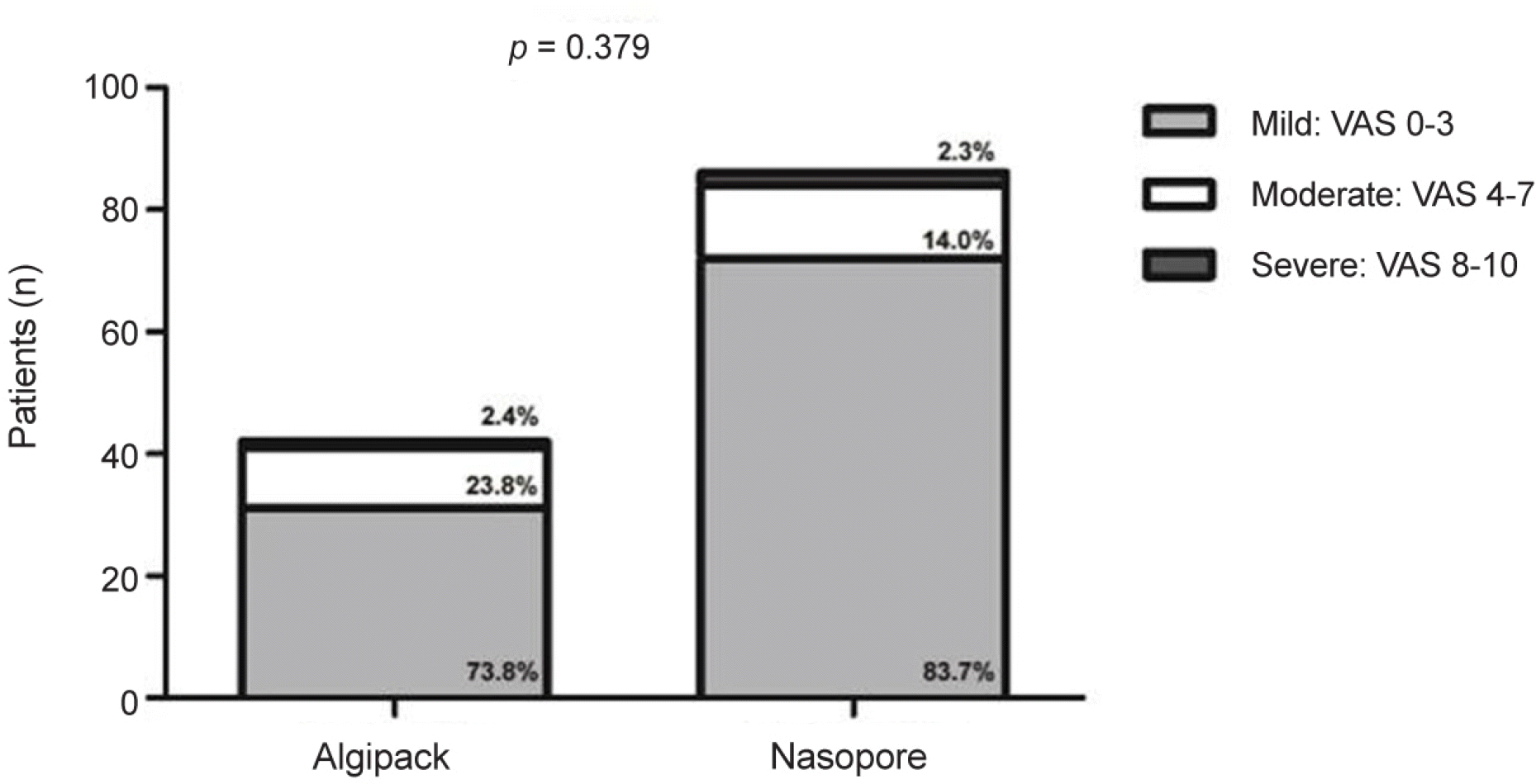Abstract
Purpose
To compare the effectiveness of calcium alginate (Algi-pack®)and polyurethane foam (Nasopore®), two types of absorbable packing used for nasal packing after endonasal dacryocystorhinostomy.
Methods
We performed a retrospective chart review of 128 eyes of patients who underwent endonasal dacryocystorhinostomy from January 2008 to July 2016. Algi-pack® was used to pack 42 eyes and Nasopore® in 86 eyes. We compared the two groups in terms of pain on postoperative day 2; the re-bleeding frequency within 1 week; anatomical and functional success rates 3 months after surgery; and the frequencies of postoperative complications including synechiae, granulomas, and membrane formation at 3 months postoperatively.
Results
There was no significant difference between the Algi-pack® and Nasopore® groups in terms of postoperative pain or re-bleeding rate (pain: 73.8% vs. 83.7%, p = 0.38; re-bleeding: 4.8% vs. 5.8%, p = 0.058). There was no significant between-group difference in terms of the formation of synechiae, granulomas, or membranes to 3 months postoperatively (granulomas: 33.3% vs. 29.1%, p = 0.62; synechiae: 1.2% vs. 4.8%, p = 0.21; membranes: 19.0% vs. 12.8%, p = 0.35). The functional and anatomical success rates evaluated 3 months after surgery also did not differ significantly between the two groups (anatomical success: 100% vs. 97.7%, p = 0.32; functional success: 100% vs. 95.3%, p = 0.16).
Go to : 
REFERENCES
1). Moore WM, Bentley CR, Olver JM. Functional and anatomic results after two types of endoscopic endonasal dacryocystorhinostomy: surgical and holmium laser. Ophthalmology. 2002; 109:1575–82.
2). Rosen N, Sharir M, Moverman DC, Rosner M. Dacryocystorhinostomy with silicone tubes: evaluation of 253 cases. Ophthalmic Surg. 1989; 20:115–9.

3). Fayet B, Racy E, Assouline M. Complications of standardized endonasal dacryocystorhinostomy with unciformectomy. Ophthalmology. 2004; 111:837–45.
5). Durrani OM, Fernando AI, Reuser TQ. Use of a novel topical hemostatic sealant in lacrimal surgery: a prospective, comparative study. Ophthal Plast Reconstr Surg. 2007; 23:25–7.

6). Konuk O, Kurtulmusoglu M, Knatova Z, Unal M. Unsuccessful lacrimal surgery: causative factors and results of surgical management in a tertiary referral center. Ophthalmologica. 2010; 224:361–6.

7). Chandra RK, Kern RC. Advantages and disadvantages of topical packing in endoscopic sinus surgery. Curr Opin Otolaryngol Head Neck Surg. 2004; 12:21–6.

8). von Schoenberg M, Robinson P, Ryan R. Nasal packing after routine nasal surgery–is it justified? J Laryngol Otol. 1993; 107:902–5.
9). Ozcan C, Vayisoglu Y, Kiliç S, Gorür K. Comparison of rapid rhino and merocel nasal packs in endonasal septal surgery. J Otolaryngol Head Neck Surg. 2008; 37:826–31.
10). Chevillard C, Rugina M, Bonfils P, et al. Evaluation of calcium alginate nasal packing (Algostéril) versus Polyvinyl acetal (Merocel) for nasal packing after inferior turbinate resection. Rhinology. 2006; 44:58–61.
11). Okushi T, Yoshikawa M, Otori N, et al. Evaluation of symptoms and QOL with calcium alginate versus chitin-coated gauze for middle meatus packing after endoscopic sinus surgery. Auris Nasus Larynx. 2012; 39:31–7.

12). Sirimanna KS. Calcium alginate fibre (Kaltostat 2) for nasal packing after trimming of turbinates–a pilot study. J Laryngol Otol. 1989; 103:1067–8.

13). Jang SY, Lee KH, Lee SY, Yoon JS. Effects of nasopore packing on dacryocystorhinostomy. Korean J Ophthalmol. 2013; 27:73–80.

14). Rose GE. The lacrimal paradox: toward a greater understanding of success in lacrimal surgery. Ophthal Plast Reconstr Surg. 2004; 20:262–5.

15). Wang YP, Wang MC, Chen YC, et al. The effects of Vaseline gauze strip, Merocel, and Nasopore on the formation of synechiae and excessive granulation tissue in the middle meatus and the incidence of major postoperative bleeding after endoscopic sinus surgery. J Chin Med Assoc. 2011; 74:16–21.

16). Weber R, Keerl R, Hochapfel F, et al. Packing in endonasal surgery. Am J Otolaryngol. 2001; 22:306–20.

17). Shoman N, Gheriani H, Flamer D, Javer A. Prospective, double-blind, randomized trial evaluating patient satisfaction, bleeding and wound healing using biodegradable synthetic polyurethane foam (NasoPore) as a middle meatal spacer in functional endoscopic sinus surgery. J Otolaryngol Head Neck Surg. 2009; 38:112–8.
18). Park DY, Chung HJ, Sim NS, et al. Comparison of calcium alginate and carboxymethyl cellulose for nasal packing after endoscopic sinus surgery: a prospective, randomised, controlled single-blinded trial. Clin Otolaryngol. 2016; 41:234–40.

19). Baek JS, Jang SY, Park TS, et al. Clinical results of Nasopore(R) nasal packing on endonasal dacryocystorhinostomy. J Korean Ophthalmol Soc. 2013; 54:557–61.
20). Wu W, Cannon PS, Yan W, et al. Effects of Merogel coverage on wound healing and ostial patency in endonasal endoscopic dacryocystorhinostomy for primary chronic dacryocystitis. Eye (Lond). 2011; 25:746–53.

21). Lee J, Lee H, Lee HK, et al. Effectiveness of synthetic polyurethane foam as a nasal packing material in endoscopic endonasal dacryocystorhinostomy. J Craniofac Surg. 2015; 26:2207–11.

22). Ahn SM, Kim SS. Clinical application of polyether ester urethane in endonasal dacryocystorhinostomy. J Korean Ophthalmol Soc. 2012; 53:743–8.

Go to : 
 | Figure 1.Calcium alginate (Algi-pack®). (A) Photograph of Algi-pack before insertion into the nasal cavity. (B) Clinical photographs demonstrating changes in Algi-pack® during postoperative follow-up. POD = postoperative day. |
 | Figure 2.Comparison of re-bleeding that required re-packing within postoperative day 7. (A) There was no significant difference in re-bleeding within postoperative day 7 between Algi-pack® and Nasopore® groups. (B) There was no significant difference in re-bleeding between the group on antiplatelets and the group not on antiplatelets. |
 | Figure 3.Comparison of visual analogue scale (VAS) results for postoperative pain on postoperative day 2. There was no significant difference in pain on postoperative day 2 between Algi-pack® and Nasopore® groups. |
Table 1.
Demographics and clinical data of subjects enrolled in this study
Table 2.
Comparison of anatomical and functional success rates between Algi-pack® and Nasopore® groups
Values are presented as number (%) unless otherwise indicated. p-values less than 0.05 were considered significantly. Pearson's chi-square and Fischer exact test were used. Postoperative nasal findings were assessed using a nasal endoscope, and any granulation, synechiae, and membrane formation within 1-2 mm of the nasal ostium were identified in postoperative 3 months.




 PDF
PDF ePub
ePub Citation
Citation Print
Print


 XML Download
XML Download